Abstract
The purpose of this study was to investigate the effects of dietary habits and nutrient intakes on skin condition of female university students. The subjects were 95 female university students in Daegu. This study examined anthropometric measurements, dietary intake, food intake habits and skin condition (moisture, elasticity, sebum (U-zone, T-zone), pores, evenness and melanin pigmentation. The subjects in this study had an average age of 21.4, an average height and weight of 161.2 cm and 52.9 kg, respectively, and the average body mass index (BMI) was 20.3 kg/m2. The means of skin elasticity, pores, evenness, and melanin pigmentation were within the normal range of women in their 20s and the skin moisture state was slightly lower than the normal range, which showed a dry tendency. The sebum in the U-zone and the T-zone was lower than the standard values, which showed less secretion in both areas. The subjects with high nut intake showed a better skin pore state (p < 0.05). Those with a high intake of instant foods showed a sig-nificantly low skin moisture and a significantly higher sebum rate (p < 0.05). The group with high skin elasticity and the group with less melanin pigmentation showed a significantly low animal protein intake (p < 0.05). The group with high skin elasticity also showed a significantly higher vitamin A and niacin intakes as well (p < 0.05). The group with high skin evenness showed a significantly lower animal lipid intake and a significantly higher vitamin E intake (p < 0.05). In addition, those with high skin elasticity and evenness as well as low melanin pigmentation showed a tendency of high intake of antioxidant vitamins, such as vitamin A, carotene, vitamin C or vitamin E. In summary, a moderate intake of plant-based products and also the antioxidant vitamins within such products seems to have a beneficial effect on maintaining a healthy and good skin condition.
Figures and Tables
References
1. Kim NI. Role of vitamines and minerals on skin care and beauty. Food Sci Ind. 2005. 38(2):16–25.
2. Pathak MA. Sunscreen: topical and systemic approaches for protection of human skin against harmful effects of solar radiation. J Am Acad Dermatol. 1982. 7:285–312.

3. Boelsma E, Vijver L PL, Goldbohm RA, Klopping-Ketelaars I AA, Hendriks H FJ, Roza L. Human skin condition and its associations with nutrient concentrations in serum and diet. Am J Clin Nutr. 2003. 77:348–355.

4. Kim MS. Skin Management. 2001. Hyunmunsa Publishing.
5. Sylvia AW, Rainer HM. The influence of sold lipid nano-particles on Skin hydration and viscoelasticity-in vivo study. Eur J Pharm Biopharm. 2003. 50:161–178.
6. Kim JH, Jung WJ. An analysis of dietary intakes and plasma biochemical indices in female college students by skin types. Korean J Community Nutr. 1999. 4(1):20–29.
7. Kim JH, Ahn HJ, Lee SE. Body Composition, food intake and clinical blood indices of female college students by skin types. Korean J Community Nutr. 2003. 8(6):977–985.
8. Lee JH, Kim JS, Lee MY, Chung Sh, Chang KJ. A study on weight-control experience eating disorder and nutrient intake of college students attending web class via the internet. Korean J Community Nutr. 2001. 6(4):604–616.
9. Cheong SH, Kwon WJ, Chang KJ. A comparative study on the dietary attitudes, dietary behaviors and diet qualities of food and nutrition major and non-major female university students. Korean J Community Nutr. 2002. 7(3):293–303.
10. Seo DH, Park GS, Shin YJ. The dietary habits and preference of food on skin types of women college students. Korean J Food Cult. 2005. 20(1):15–20.
11. Shin DS, Cho OK. The eating-related characteristics questionnaire and its correlations with anthropometry, nutrient intake, depression, and personality dimensions: the validity of its use on Korean college students. Korean J Nutr. 2002. 35(4):489–497.
12. Boelsma E, Hendriks HFJ, Roza L. Nutritional skin care: health effects of micronutrients and fatty acids. Am J Clin Nutr. 2001. 73(5):853–864.

13. Ha MH. Relation of eczema skin and diets: in students of middle and high schools in Busan [Master's Degree Thesis]. 1995. Busan: Kyonsung University.
14. Kim SH. Characteristics of nutritional status and dietary behaviors of obese women in Bucheon [Master's Thesis]. 1998. Busheon: Catholic University.
15. Hong YS. A study on the control of obesity and the skin care of female adult according to the lifestyle [Dissertation]. 2005. Seoul: Sungshin Woman's University.
16. Horribon DF. Essential fatty acid metabolism and its modification in atopic eczema. Am J Clin Nutr. 2000. 71:suppl. 367s–372s.
17. Kim EA. Phytochemicals and beauty food. Food Sci Ind. 2007. 40(4):3–9.
18. The Korea Nutrition Society. Dietary reference intakes for Koreans. 2005. Seoul:
19. Bae HS, Cho YH, Kim JY, Ahn HS. Comparison of nutrient intake and antioxidant status in female college students by skin types. Korean J Community Nutr. 2006. 11(1):63–71.
20. Ko YS, Ahn HS. Seasonal difference of nutrient intake, serum lipid and antioxidative index in female college students. Korean J Community Nutr. 2007. 12(2):142–149.
21. Kim MY, Cho KD, Beak OH, Lee BH. Effects of body composition, nutrient intakes and biochemical indices on skin health status of female university students with sensitive skin. Korean J Food Cult. 2008. 23(2):258–267.
22. Kumar S, Anthony J, Megan B, Susan K. Developing a moisurizer for sensitive skin. J Am Acad Dermatol. 2005. 52(3):68.
23. Doering T, Brade H, Sandhoff K. Sphingolipid metabolism during epidermal barrier development in mice. J Lipid Res. 2002. 43:1727–1773.

24. Park YS, Rou FR, Jaegal SA. Relationship between nutritional status and facial sebum content of young women. Korean J Community Nutr. 2006. 11(5):587–597.
25. Chung UJ. Risk factors for troubled skin focused on eating habits and food preferences of college women. Journal of the Korean society of Fashion & Beauty. 2007. 5(1):24.
26. Kim SM, Kim EW. Changes in the skin health conditions by facial skin care and antioxidant vitamins. Korean J Aesthet Soc. 2009. 7(4):111–125.
27. Simon A, Heinrich Ulrike, Wilhelm S, Hagen T, Sheila W. Dietary Carotenoida Contribute to Normal Human Skin Color And UV Photosensitivity. J Nutr. 2002. 132:399–403.
28. Bowman BA, Russell RM. Present knowledge in nutrition. 2003. eight edition, Traslation. Seoul: The Korean Nutrition Society.
29. Kim HJ. Skin health condition related factors and evaluation index of women in early twenties. J Korean Soc Cosm. 2005. 11(3):210–216.
30. Lee J, Jiang S, Levine N, Watson RR. Carotenoid supplementation reduces erythema in human skin after simulated solar radiation exposure. Proc Soc Exp Biol Med. 2000. 223(2):170–174.

31. Djerassi D, Machlin L, Nocka C. Vitamin E. Biochemical function and its role in cosmetics. Drug Cosmet. 1986. 29–34.
32. Choi EY, Soon NY. A Study on factors influencing on women of skin type. J Nat Sci. 2000. 1:79–88.
33. Eberlein-Konig B, Maier T. Protective effect against sunburn of combined systemic ascorbic acid (vitamin C) and d-x-tocopherol (vitamin E). J Am Acad Dermatol. 1998. 38(1):45–48.
34. Longas MO, Bhuyan DK, Bhuyan KC, Gutsch CM, Breitweiser KO. Dietary vitamin E reverses the effects of ultraviolet light irradiation on rat skin glycosaminoglycans. Biochim Biophys Acta. 1993. 1156(3):239–244.





 PDF
PDF ePub
ePub Citation
Citation Print
Print









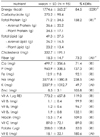
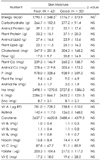
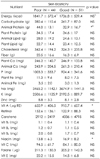
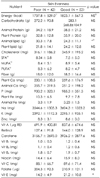
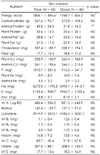
 XML Download
XML Download